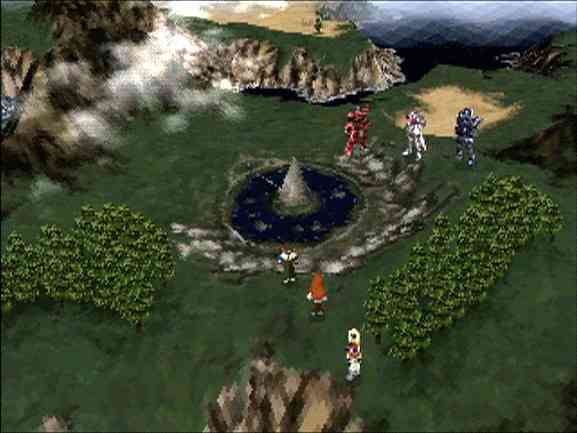Welcome to part 3 of The Retro Review Series’ second episode, covering Xenogears. If you’re just jumping in now don’t miss parts one and two, ‘The Intro‘ and ‘The History‘.
Xenogears’ priority is its story. If you choose to play it, you will be doing lots of reading and watching. I know that I wrote about Final Fantasy VII’s plot being wonderful and epic, and for my money, this is the only game that really comes close to being as incredible. The Xenogears plot does conquer Final Fantasy VII in terms of epic scope, however.
The story takes place on Ignas, a continent which houses two major countries, called Aveh and Kislev, which are at war with each other. Our protagonist, Fei, has amnesia, and has lived in a village called Lahan on the border of these two countries for as long as he can remember. The game opens with an attack on Fei’s village, where he gets in a Gear (giant humanoid Japanese robot vehicle) and fights the attackers. It appears that the attackers are after the mysterious Gear that Fei has used, and even though he has no memory of piloting a Gear, Fei battles the attackers, which leads to the destruction of the village. During this time, Fei has visions of a child who looks like him, piloting the Gear, whilst covered in blood.
Fei’s story quickly becomes a globetrot of epic proportions. Without giving too much away, the story spans multiple continents, takes to the sky, involves an insane number of characters (9 of which are useable), and features some of the most complex plot I’ve ever experienced. Uncovering the secrets of Fei’s past is a huge driving force of the narrative. As an example of one of the many incredible plot elements of this game: there is a masked, caped, villainous-looking character named Grahf wants to awaken hidden destructive power within Fei, and destroy God. Rad.
There is a very creepy moment early on in the game, where a character grabs their head, and has an “Akira-style” freak out while surrounded by dead bodies, which leaves the viewer of the story freaking out about where this insane psychic element of the plot came from. Later on, the game uses the fantastic plot device of Battle Angel Alita-style floating cities, where you will be dying on the inside to know what it’s like up there. This is the kind of plot structure designed for people who wanted to know Wolverine’s origin in the 90s, or what was happening on the island in Lost in the 00s. I would estimate that about 50% of the 80 hours it took me to beat Xenogears, was spent reading and watching cutscenes.
Gameplay-wise, Xenogears is a JRPG through and through. It features an ATB combat system, a world map, random battles, towns with shops, text box dialogue, bubbly freak creatures, and a teenager trying to save the world, but there are several unique gameplay elements, which set it apart from its contemporaries.
Exploring involves a 360 degree view, and mild platforming challenges. When navigating towns or forests, many of the best items are hidden in areas that involve fully rotating the camera, in order to view the entire area. There are plenty of chests that can only be reached though completing simple puzzles, which often involve jumping obstacles. This adds a very welcome extra flavor to dungeon crawling, which very much does not feel like dungeon crawling.
Click on thru to page two as we dissect the combat, music and graphics and more…

